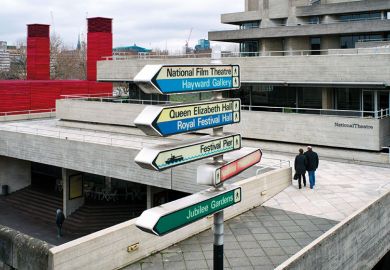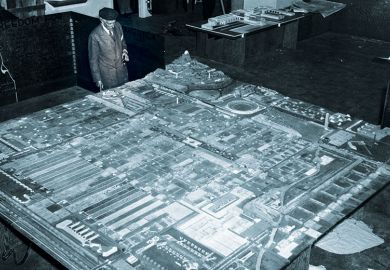The new Sir Banister Fletcher’s Global History of Architecture is a major monument in the writing of worldwide history, covering five and a half millennia of architecture across all the inhabited continents. It plausibly claims to be the largest collaborative work of scholarship yet conducted in the field of architectural history, drawing together 88 scholars to produce overviews of regions and periods in which they are prominent or leading researchers.
The new Banister Fletcher (as it will doubtless continue to be called by most) is the 21st edition of a chunky classic that has been bending architects’ bookshelves since its first edition in 1896. It has changed and expanded over its long life; and this edition is a complete, ambitious rewrite, claiming numerous firsts: the first edition to fill two large volumes rather than one; the first to give bylines to all its scholarly contributors; the first to have colour illustrations; and, by far its most important claim, the first to attempt truly global coverage.
A first-rate world history of architecture is not merely timely but urgent, for scholarly purposes and for teaching. UK architecture schools attract students from all over the globe, and grinding through the traditional survey course of “Western” architecture from ancient Greece to the apotheosis of modernism is both bad manners and bad education, ill-suiting a body of students who come from all over the world, and who will work all over the world.
So how good is this edition, and how well does it equip students, lecturers and researchers to escape the substantial gravitational pull of “the Western tradition”? The answers are cheering: these two hefty, scholarly volumes will help immeasurably in allowing English-speaking students and scholars to step outside their traditional comfort zone and see architecture in its truly global complexity and richness.
The name “Banister Fletcher”, recalling the father and son authors of early editions, is an unlikely standard-bearer for de-westernising architectural history. The first editions were exclusively European in content until the fourth added an appendix on “The Non-Historical Styles”, which included Byzantine, “Indian” and “Saracenic”. A “tree of architecture” shown in early editions had a central trunk of Graeco-Roman classicism, with most of the world’s architecture consigned to fruitless side branches.
Banister Fletcher’s latest identity, rebalancing architectural history away from its Eurocentric past, has been forged through the appointment of Murray Fraser as general editor. Fraser, whose strong intellectual leadership and extensive international network are apparent in the framing, structure and introductory passages of the new edition, is a prominent academic critic of precisely those postures of authority and objectivity, and the unquestioned assumption of Western superiority, with which the Banister Fletcher brand originated.
So he has rebalanced the book considerably: about 60 per cent of the text’s million words relate to the history of areas other than Europe and North America, the regions that have traditionally dominated surveys of architectural history. And the graphic cover image of a column capital is not Graeco-Roman but rather from a Persian apadana.
The potential antagonism between editor and book turns out, in fact, to be the work’s greatest strength. Fraser’s embrace of pluralism and potential contradiction allows authors to speak with their own voices and to inflect their chapters (typically a few decades or centuries across a continent or large region, covered in about 10 to 30 pages) with their own academic priorities and understandings. This provides changes of rhythm and accent, and allows the best stylists in an impressive list of contributors to write with energy and flair.
Some chapters, especially for recent periods, take strong positions of taste or ethics (such as the condemnation of Dubai’s absurdly energy-wasting artificial islands in cartoonish shapes), while others are classically stylistic in their discussion, tracing influences and developing ideas and motifs (the Italian Renaissance and baroque is told in this well-established manner), and a few read more like tours of key monuments.
Within this variety, standardisation of format makes the book, and its accompanying subscription website for universities, navigable and easy to use. Each chapter begins with a couple of pages of broad context under the recurrent headings “history and geography” and “culture and society” – a nod, perhaps, to similarly named roots on Banister Fletcher’s 1905 tree of architecture. After a more substantial main section on “architecture”, each chapter ends with a selection of “key buildings” and a relatively brief list of “further reading”. This last can be tantalising if there is a specific point you wish to follow up, but the immense apparatus of footnotes that would otherwise be required would clearly be prohibitive to print. Perhaps future online editions could provide references, just as on-screen users already benefit from large, good-quality images freed from the size constraints of print.
From a scholarly point of view, the book shows up the huge disparity in the amount of serious research conducted in English on the architecture of different parts of the globe and different periods. Of the 12 items in the “further reading” section for Liao Dynasty to Yuan Dynasty China, for instance, only four are in English. Yet the chapter includes the largest city known to humanity before the Industrial Revolution, and covers a fascinating attempt at government-led standardisation of architecture and construction through the Yingzao Fashi. By contrast, the literature for the relative backwater of early medieval Europe is hugely abundant and very good, despite a population perhaps a quarter the size of China’s, and architecture that was predominantly rudimentary and technologically unsophisticated by comparison. It is wonderful that Europe has such a rich literature, but the new Banister Fletcher reveals the boundless intellectual opportunities available to those prepared to acquire the languages and cultural knowledge to work on Chinese, African or South American architecture.
Many or most of the new Banister Fletcher’s chapters constitute the best medium-length, up-to-date overviews of their subjects in English. For well-trodden areas, there are certainly monographs that cost and weigh less and would give a more detailed view of subjects such as the Italian Renaissance, French Gothic or early US skyscrapers. However, the coverage of each in Banister Fletcher is good, scholarly and readable – leading figures pulling together a valuable state-of-the-field write-up. For Western readers, the presence of familiar and less familiar architectures side by side usefully debunks any sense of primacy and challenges over-convenient generalisations.
Both print and online versions are intelligently and thoughtfully detailed: coloured page ends ease physical navigation, while online page numbers and page divisions are indicated unobtrusively, allowing proper referencing in a way that some digital versions of academic books unforgivably neglect.
Every university library should subscribe to the online edition. In print, the cover price of £350 is worth paying for such rich, broad coverage, but many potential readers will be deterred by it. I urge the publishers to consider an affordable, well-bound paperback in due course; this is a book that deserves to be on the shelf not only of every architect and architecture student, but of anyone who wants to know more about the history of the world. Browsing through its thousands of pages, with their 2,200 illustrations, reveals architecture’s unique place as an index of human achievements, priorities, contradictions and identities – a dazzling visual history of world culture. Everyone will find in it new understanding and new pleasures.
Barnabas Calder is senior lecturer in architecture at the University of Liverpool. He is currently completing a history of the relationship between architecture and energy, to be published next year by Pelican.
Sir Banister Fletcher’s Global History of Architecture
Edited by Murray Fraser
Bloomsbury, 2,144pp (two volumes), £350.00
ISBN 9781472589989
Published 14 November 2019
The author
Murray Fraser, professor of architecture and global culture at the Bartlett School of Architecture, UCL, was born in a Glasgow tenement. His parents, he recalls, “were part of the 1960s social dream and so moved out to East Kilbride, the first New Town in Scotland, some 8 miles south of the city. My father was a civil servant, and when I was 12 years old he was transferred to London. Rather predictably, our new home was in Hemel Hempstead, the third of the English New Towns.”
Going to the Bartlett School, from which he now has five degrees, Fraser qualified as an architect but also took the MA in architectural history in the year it was launched (1981) and then went on to a PhD. The experience, he says, has “encouraged [him] ever since to enjoy an equal interest in past and contemporary design”. Since his research from the start was “rooted in cultural studies, more specifically post-colonialism”, he became “one of the first architectural scholars to engage with theories of globalisation”. This meant that “the lopsided nature of the subject was readily apparent. Some still today write as if architecture were a Western invention with buildings in other parts of the world simply as bizarre alternatives.”
With his new book, therefore, Fraser hopes to help “broaden the geographical and cultural range of what architects are taught [and] accentuate the importance of a deep historical understanding of what we do and what we build. My key argument is that the most creative architectural changes – such as the spread of Buddhist temple design across China, Korea and Japan, or the remarkable innovations of modernist buildings in 20th-century Latin America – have always arisen from the cross-flows of ideas and influences and networks around the globe, not from the relative stasis of monocultural or nationalistic conceptions.”
Matthew Reisz
Register to continue
Why register?
- Registration is free and only takes a moment
- Once registered, you can read 3 articles a month
- Sign up for our newsletter
Subscribe
Or subscribe for unlimited access to:
- Unlimited access to news, views, insights & reviews
- Digital editions
- Digital access to THE’s university and college rankings analysis
Already registered or a current subscriber?








